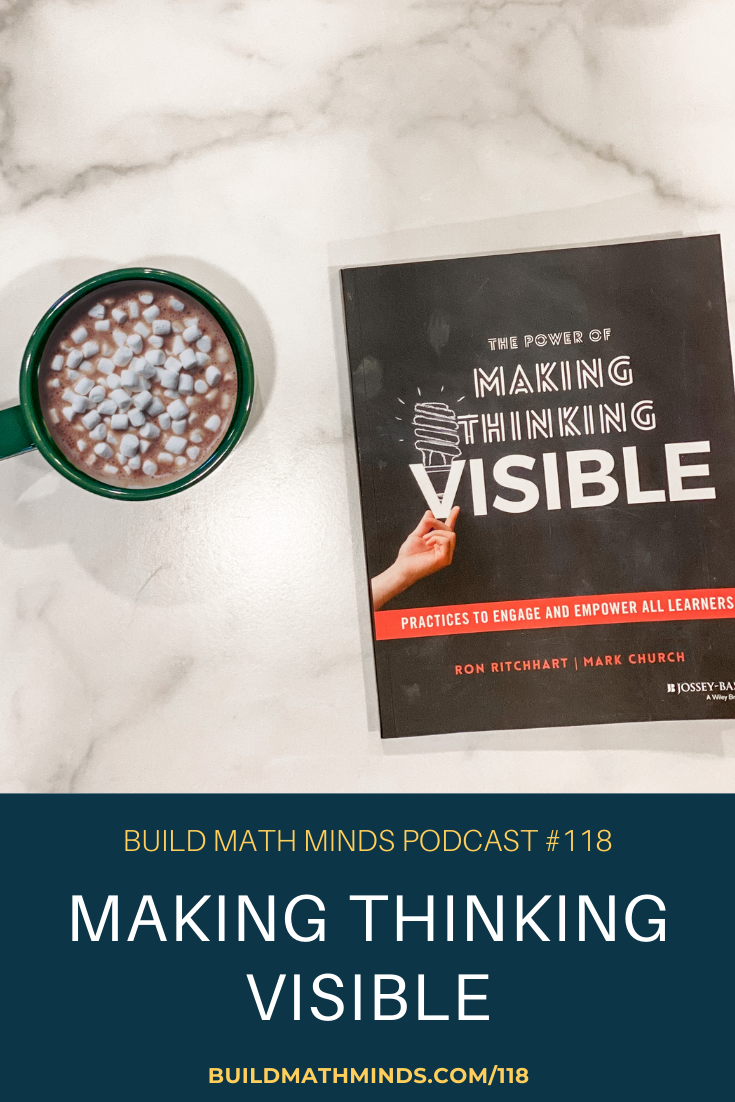Resources mentioned in this episode:
The Power of Making Thinking Visible: Practices to Engage and Empower All Learners by Ron Ritchhart and Mark Church
Welcome fellow Recovering Traditionalists to Episode 118. Today lets explore ways of Making Thinking Visible.
The book The Power of Making Thinking Visible: Practices to Engage and Empower All Learners by Ron Ritchhart and Mark Church isn’t a book about teaching math. It’s a book full of ideas on how to bring out your students’ thinking no matter what subject.
I talk a lot about letting kids share their own ways of thinking about math problems and then using what you hear & see from them to guide your instruction. But if you and your students aren’t used to it, it’s often hard to even get them started. On page 24 the authors say this:
“Thinking is an internal process, something that happens in the working of the individual mind. As such, it can seem mysterious and inaccessible – hence the need to make it visible. We use the term ‘visible’ here not just to represent what can be seen with the eye but also what we can perceive, notice, and identify. When we make thinking visible it becomes apparent to all, teachers as well as students. It then becomes something that then can be analyzed, probed, challenged, encouraged, and advanced. Four practices are used to make thinking visible:
- Questioning
- Listening
- Documenting
- Thinking Routines
Although each can be discussed, examined, and reflected upon separately, in reality they exist as integrative practices that enhance and complement one another.”
To give you a little more information about each of the 4 practices I’d like to share a snippet of their descriptions on pages 25-28.
“Questioning
Questions not only drive thinking and learning, they are also outcomes of it. As we engage with new ideas and develop our understanding new questions emerge. Voltaire famously said to ‘judge a man [sic] by his questions rather than by his answers’ as they are likely to reveal a person’s real depth of understanding as well as their engagement with the issue….
Listening
Of course, there is no reason to ask good questions if one is not listening for the answers. It is through our listening that we provide the opening for students to make their thinking visible to us. It is only when students know that we are truly interested in their thinking that they have a reason to share it with us. Thus, listening is not only a practice in which we teachers must engage, it is also a stance we must assume in the classroom….
Documentation
The processes of thinking and learning can be elusive and ephemeral. Documentation is the effort to capture this process in as much richness as possible. But where does thinking reside? Is it in the answers students give us? The finished work they offer? Although these artifacts may contain residues of thinking, too often thinking and learning are obscured in the effort to get good marks and produce correct answers. We are more likely to find thinking in the messy process of working through ideas over time as we are in the final product. When we can capture this process it provides us with a vehicle for analysis of and reflection on the thinking…
Thinking Routines
Thinking routines are a central practice for making thinking visible. They operate as tools to prompt and promote thinking, as structures that reveal and scaffold thinking, and through their use over time routines become patterns of behavior. We have found that in learning to use thinking routines effectively, it is useful to understand each of these three levels: tools, structures, and patterns. Although in the following discussion we present each as distinct, it is important to recognize that thinking routines operate on these three levels simultaneously. Even as we attend to the tool-like aspect of a thinking routine, we recognize it is also helping to structure and scaffold the thinking. At the same time, the routine is slowly becoming a pattern of behavior.”
The majority of the book is detailing lots of different thinking routines and embedding in information about documentation, listening, and questioning during those routines. These are essential practices to put into place to help you learn how to change up your teaching to allow space for students to share their thinking and for your students to learn how to actually share their thinking. So if you are working on encouraging your students to do more of the thinking and talking in class and would like some routines to help you do that, go get this book. I’ll link it up over at buildmathminds.com/118
Subscribe and Review in iTunes
While you’re there, don’t forget to leave a review on iTunes too. I would love to know your thoughts and how we can make sure that we give you content that you will really enjoy.
To leave a review, head over to iTunes and click on “Ratings and Reviews” and “Write a Review.” I can’t wait to hear your thoughts about the podcast.





Thank you for all you do!
I am a recently retired elementary math teacher. I enjoy listening to the ideas you present. I have a 8 year old grandaughter. I try out your ideas with her. Keep up the good work.
I love your podcasts and find them truly enlightening, practical and encouraging during these challenging teaching and learning times. We are out here listening faithfully.
Christine, thank you for making these podcasts. They are really good at showing where we as teachers can make changes that impact students learning and ours.
Hi,
I love your approach and listen to your podcasts when I have time, not as often as I’d like. I wish you had touched on one or two Thinking Routines we might find in the book…maybe an unusual one…because I might not buy the book, but would if I were hooked!